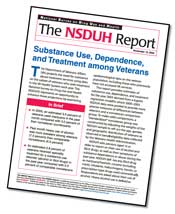Two Reports: Substance Use Among Veterans
 Substance
use, dependence, risk behaviors, and treatment are the
focus of two new SAMHSA short reports on American veterans. Substance
use, dependence, risk behaviors, and treatment are the
focus of two new SAMHSA short reports on American veterans.
The reports present data that show veterans are more
likely than non-veterans to use alcohol and marijuana,
smoke cigarettes daily, and drive under the influence
of alcohol or illicit drugs. Veterans are also more likely
to receive treatment for a substance abuse disorder.
 Both
reports are based on data from the National Survey on
Drug Use and Health (NSDUH). Both
reports are based on data from the National Survey on
Drug Use and Health (NSDUH).
One report shows that in 2003, an estimated 3.5 percent
of veterans had used marijuana in the past month, compared
with 3.0 percent of their non-veteran counterparts. Past-month
heavy use of alcohol was also more prevalent among veterans
(7.5 percent) than comparable non-veterans (6.5 percent).
An estimated 0.8 percent of veterans had received specialty
treatment for a substance use disorder (alcohol or illicit
drugs) in the past year, compared with 0.5 percent of
comparable non-veterans. Substance
Use, Dependence, and Treatment among Veterans.
The second report, Alcohol
Use and Alcohol-Related Risk Behaviors among Veterans,
shows that in 2003, an estimated 56.6 percent of veterans
used alcohol in the past month compared with 50.8 percent
of comparable non-veterans. An estimated 13.2 percent
of veterans reported driving while under the influence
of alcohol or illicit drugs in the past year, compared
with 12.2 percent of comparable non-veterans. An estimated
18.8 percent of veterans reported smoking cigarettes
daily in the past month, compared with 14.3 percent of
comparable non-veterans.
In 2003, there were an estimated 25 million veterans
comprising roughly 11.5 percent of the 217 million non-institutionalized
civilians age 17 or older in the United States. Approximately
93 percent of veterans were male, and 8.4 percent were
between age 17 and 34. An estimated 30.1 percent were
between age 35 and 54; 42.3 percent between age 55 and
74; and 19.2 percent age 75 or older.
The reports, Substance
Use, Dependence, and Treatment among Veterans and
Alcohol
Use and Alcohol-Related Risk Behaviors among Veterans,
are available from SAMHSA's National Clearinghouse for
Alcohol and Drug Information at P.O. Box 2345, Rockville,
MD 20847-2345. Telephone: 1 (800) 729-6686 (English and
Spanish) or 1 (800) 487-4889 (TDD). 
« See Also—Previous
Article
See Also—Next Article »
Back to Top
|




